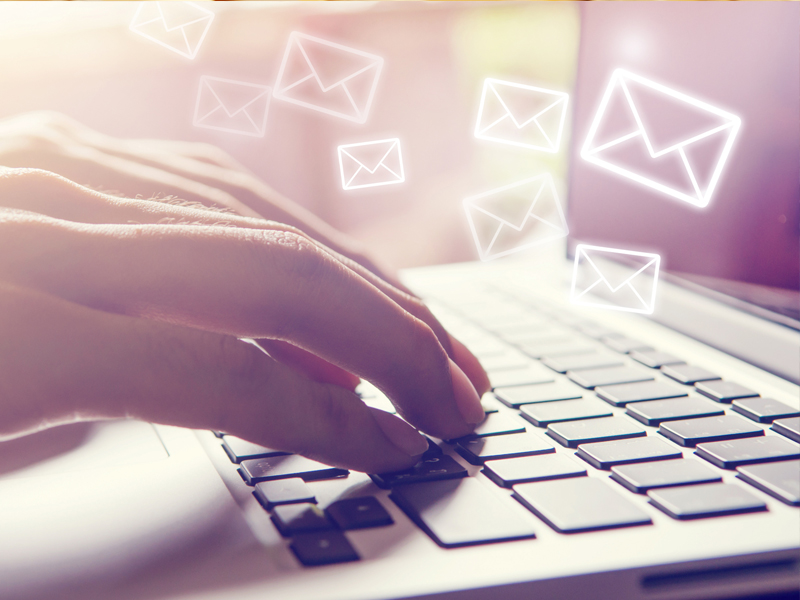One of the most dreaded activities that executives have got to face is treading through an overwhelming amount of electronic messages. In this article, the author shares a new perspective that can get you through an email overwhelm, useful hacks to put into practice, and one message that needs to be your new mantra.
Now, more than ever, we rely on technology as the primary form of business communication. In fact, in any given day the average business person has to contend with at least 150 emails, 10 text messages, and a few dozen business-related social media and messenger alerts. In addition, busy managers can face the dilemma of a dozen or more unplanned inbound phone calls, unscheduled employee walk-ins dealing with everything from urgent client matters, to new ideas, or unsolicited, untimely feedback. It’s no wonder that so many of us find ourselves ever-stuck in a cycle of communication overwhelm and daily distraction from core goals and responsibilities. We are also in a culture that has evolved into expecting immediacy in response-time and demand on our resources.
What if, however, much of the urgency we perceive was actually “false urgency”? What if, for lack of a system for dealing with a heavy volume of e-communications, we were instead just looking for a scapegoat for our lack of efficiency, or ability to prioritise. After all, if we were so busy dealing with every communication, unconsciously trying to please everyone with a timely and thorough response, and blindly prioritising all requests as equally worthy of our time, we could then blame the company, or outside forces, or the technology itself. The problem couldn’t possibly lie with me and my inability to manage. Or could it?
[ms-protect-content id=”5662″]
Coming to Grips with Email Reality
The reality for the manager or executive is that we really do have a fair amount of control over certain communications processes, business procedures and processes, and staff. By developing our own control mechanisms, and internal communication culture, we can better manage or reduce communication volume, and with a little effort actually shift it into an effective time management paradigm, where we go back to using the technology as a tool for increased productivity, rather than the technology owning us.
Tips on How to Tame the Email Overwhelm Beast
Email Block Time. Choose the times in advance when you will check email, how much time you will spend responding, and limit the number and length of responses you are allowed in each cycle. Carving out blocks of time to tackle email may take some getting used to, but you will find that you can become more productive in other tasks you are obligated to. Giving 100% of your attention to the task at hand instead of an overflowing email inbox gives you the focus you need to get things done. Additionally, though we all do it from time to time, clicking that email icon on your phone the minute you wake up is not the optimal time for anyone to start checking email. This is the fastest way to overwhelm yourself the minute you wake up, and possibly miss some important messages while you are still adjusting to the stark brightness on your screen. Your email check block can still happen before business hours early in the morning, but try not to make it before your feet hit the floor getting out of bed.
Email Response Jujitsu: This concept takes all the energy coming towards you on an inbound email, and allows you to quickly redirect that energy towards a more effective form of communication, and also defers the communication timeline.
Not all emails require a timely reply, so only respond when necessary. For those emails that do require a response, you may find it can be a very brief response that conditions the recipient towards more practical communications patterns. Consider short, succinct replies like these:
“Received, thank you. Will add this to the discussions at our upcoming meeting”
“Can we set a brief call later this week to step through this and develop an action plan?”
“Thanks. Good idea. Please be sure to add this to our R&D ideas list for consideration at the next quarterly meeting, when we’ll have time to appropriately address.”
The strategy here is to confirm that you have received the message, but that at a more mutually optimal time, you would like to flush out their ideas. This way, the recipient won’t feel ignored, and you are able to divert your attention to them more fully at another time.
For more urgent emails that can be handled efficiently by another member of your management team, you can always redirect the thread so that you can still be in-the-know, but issues are tackled with more immediacy. Consider a reply like this:
“Thank you, I am including John on this email, as he will be handling the day-to-day on this account.”
Cultural Email Protocol Training: You can also condition internal stakeholders, staff, or even your boss to keep a list of things they need to discuss and then share just the list in a single summary email to be reviewed once daily in a fifteen-minute face-to-face meeting. This protocol alone could prevent dozens of email threads from ever spawning. Consolidating these less urgent threads into a bulleted list of updates ensures that you stay informed in a fraction of the time. Think about the time of day that works best for your workflow – would the end of the day serve you and other internal stakeholders best, or should this meeting occur first thing in the morning right as the caffeine kicks in? A lot of the success that I have found in business can be attributed to procedures I implement that become standard across the company. Upon on-boarding, employees are taught protocol, and though it can be improved over time, consistency limits mistakes and creates a better experience both internally, and when in contact with those outside the company.
Don’t Read Every Email: It can be immensely helpful to have an assistant or executive admin read your email and identify patterns of communications and email filtering so you only need to read the important messages from the right people, and not be distracted by vendor pitches, unsolicited service offerings, newsletter subscriptions and other daily email distractions that the admin can route elsewhere, respond to, or bring to your immediate attention. Having a trusted second set of eyes on your email may even help you catch things you may have otherwise missed. Though this tip may be easier said than done to implement, releasing the grip on your inbox will free you up to re-channel your attention where it is truly needed. Managers are commonly cc’d on emails, but that does not necessarily mean that your attention should absolutely be focussed on that particular thread. The intent might only be that you can reference the email at a later date, while the meat of the discussion is handled by another point of contact. Training your team correctly, as well as trusting them is the key to mastering this idea.
Set up Automated Email Rules: If an executive admin is not right for you, utilise the tools offered through your email provider or software. Email rules can automatically file messages using inbound email filters and storage rules. For example, if there are certain clients you absolutely cannot miss, use your email rules to automatically move messages from a specific person to its own specialised folder so you never miss a beat. Your rules wizards can even grant you the power to filter messages via keyword. Newsletters can automatically be filed into their own folder while unsolicited service offerings that have a “Special Offer!” call to action can be automatically deleted or archived for later viewing.
Use the Delayed Response Feature. Email responses can be electronically delayed if you are able to draft a longer email, but want to make sure that it gets to the recipient at the most optimal time. If you feel most productive answering email during your block at 11:00pm, you can use the delayed response feature to make sure that email gets sent out at 8:59am the next morning. It is not only more professional, but the recipient will not grow accustomed to having you at their disposal out of office hours. Delayed response also reduces the chances that you glance at an email, and never answer it. If you have a short answer that is not time sensitive, but you know it will lead to a further discussion that needs to be tabled momentarily, sending a delayed response ensures that you do get back to that person, but you still have the time to finish what needs to be done before delving further into that topic.
Develop Proper “Out of Office” Etiquette. You can use, but don’t abuse the “Out of Office” (OOO) feature during days when you are in the office, but your attention needs to be in one place completely. This feature is especially helpful when travelling out of the time zone that those you are in communication with would typically find you in. Crafting the right OOO response can redirect the recipient to the appropriate person or outlet if immediate communication is required. Being transparent about why you are not currently on email is a best practice, and you should be specific about the time you’ll be away, and when you’ll return. As an example, here is a standard OOO message I’d use on a particularly busy day full of face-to-face meetings:
“Please note that I am working on-site with clients in the NYC area on [Insert date]. Therefore, I am not immediately available for phone calls and email. During this time, I will reply to urgent inquiries within 1 business day.”
“Current clients: For a timelier response, be sure to cc: your account manager on all project related email correspondence or call our main office at {XXX–XXX–XXXX} during business hours.”
“All off-hour emergency issues such as website outages may be reported 24/7 via email to Support@InteractMarketing.com for Interact hosting clients only.”
Once you have developed a message that works for you, consider duplicating your custom OOO message across all channels, including your office phone voice mail as well as your cell phone voice mail. Taking two minutes to coordinate custom OOO messages across all points of contact may save you uncomfortable conversations with clients that feel slighted by an ignored phone call.
I also find it useful to forward my cell phone to the office phones so that those trying to get in touch with me can still talk to a manager and get a resolution without waiting. Prioritising your time is important, as we all have finite hours in the day that everyone is constantly trying to get a piece of. In addition to forwarding calls, if you’re on the road with meetings all day, but those you are in contact with are more used to sending you a text message, there are apps that auto reply for you. This not only keeps you safe behind the wheel, but it’s just one more way to make sure that business associates, co-workers or potential clients know that your intention is not to ignore them. You can find apps compatible with both Apple and Android devices for most cellular carriers.
Put It Into Practice
Gone are the days of when “You’ve Got Mail!” was a thrill. The reality is that we all need to create a foundation to manage a cell phone that never stops pinging. You can tame the Email Overwhelm Beast by implementing these ideas across the company, so that everyone on your team is on the same page, and clients or customers know what to expect of your firm. Your ability to run your day starts with your confidence to take it on, full force.
Don’t let your inbox run your life.
[/ms-protect-content]
About the Author
 Joe Beccalori is a twenty-two-year digital marketing veteran and industry thought leader. After working for fifteen years in enterprise web programming, design, and marketing services he founded Interact Marketing in November 2007 and is currently the company CEO, visionary, and public speaker. He is also a contributing author on Forbes, Huffington Post, and Relevance.com.
Joe Beccalori is a twenty-two-year digital marketing veteran and industry thought leader. After working for fifteen years in enterprise web programming, design, and marketing services he founded Interact Marketing in November 2007 and is currently the company CEO, visionary, and public speaker. He is also a contributing author on Forbes, Huffington Post, and Relevance.com.


































